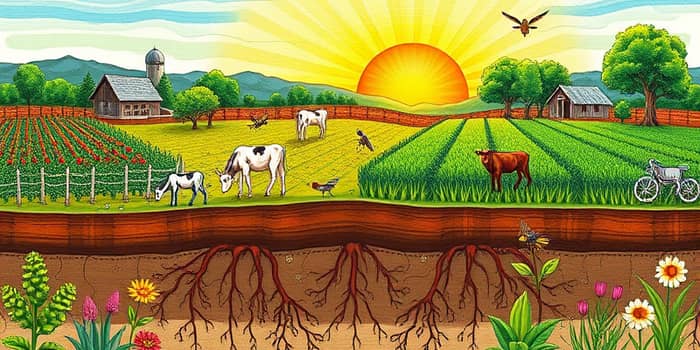Regenerative agriculture is more than a buzzword—it’s a movement reshaping our understanding of food production, land stewardship, and the future of our planet. This article breaks down the essence of regenerative farming, illustrates its transformative impacts, and offers practical steps for anyone eager to join the journey toward healthier soil and resilient ecosystems.
Understanding the Core Concept
At its heart, regenerative agriculture is a holistic approach to farming. It seeks not only to sustain current productivity but to actively restore and improve the health of soil over time. Unlike conventional or “sustainable” methods, which aim to maintain status quo, regenerative practices aspire to reverse damage and rebuild degraded lands.
Imagine farmland that gets healthier each season, with soils that hold more water, capture carbon, and support a rich web of life. By choosing to work with nature not against it, farmers foster robust ecosystems that thrive under changing climates and market pressures.
Core Principles and Practices
Regenerative agriculture relies on a suite of interlinked techniques designed to produce vibrant living soils teeming with life. Key practices include:
- Cover cropping to protect and feed the soil between main crops
- No-till or reduced-till planting to preserve soil structure and microbial networks
- Rotational and adaptive grazing to mimic natural herd movements and enrich pastures
- Intercropping and polyculture systems to increase biodiversity on the field
- Agroforestry—integrating trees with crops for shade, nutrients, and habitat
- On-farm composting and organic amendments to boost soil organic matter
Though these methods can be traced to traditional and Indigenous agricultural wisdom, modern science confirms their power to increase biodiversity and ecosystem resilience across landscapes.
Economic and Environmental Impacts
Farmers adopting regenerative practices report substantial benefits. Input costs for synthetic fertilizers and pesticides can drop by up to 50%, while profit margins often rise by 20–30%. Beyond the balance sheet, regenerative systems deliver tangible economic and environmental gains:
These numbers illustrate how regenerative practices not only combat erosion and drought vulnerability but also position farms as allies in the global fight against climate change by capturing carbon in soils.
Social and Community Benefits
Regenerative agriculture fosters healthier communities through several social advantages:
- Job creation: regenerative farms generate up to 32% more employment than conventional operations.
- Attracting young farmers: 86% of new entrants into farming embrace regenerative methods.
- Improved nutrition: healthier soils yield nutrient-dense crops, benefiting consumer health.
By revitalizing rural economies and strengthening local food systems, regenerative initiatives nurture a sense of shared purpose and resilience among producers, workers, and consumers.
Evolution and Re-Emergence
Although regenerative agriculture feels urgent in today’s climate discourse, its roots extend centuries back through Indigenous and traditional practices. The industrial era’s reliance on synthetic chemicals created short-term gains but long-term degradation. Today, farmers and researchers worldwide are rediscovering and adapting age-old wisdom to modern contexts.
There is no one-size-fits-all blueprint. Instead, each farm crafts a mosaic of techniques tailored to its soil type, climate, and community needs. This flexibility propels a dynamic movement, constantly learning from successes and challenges to refine best practices.
Getting Started: Practical Steps
Transitioning a farm or garden toward regenerative methods can feel daunting, but small actions yield big returns. Consider these steps:
- Perform a soil health assessment: test for organic matter, pH, and nutrient balance.
- Introduce cover crops on unused fields: legumes, grasses, or brassicas enrich the soil.
- Reduce tillage gradually: switch to minimum-till equipment or start with select fields.
- Plan rotational grazing paddocks: move livestock frequently to prevent overgrazing.
- Set up composting systems: recycle crop residues, manure, and foliage into rich amendments.
Over time, monitor changes in soil structure, water infiltration, and biodiversity. Celebrate small victories—like earthworms appearing in greater numbers or improved water retention after a rain.
The Road Ahead
Embracing regenerative agriculture is a journey of continuous learning and adaptation. Each field, pasture, or garden tells a unique story—as soils heal, ecosystems flourish, and communities prosper. While challenges remain, from policy barriers to market access, the growing consumer demand for regeneratively produced foods ($29.7 billion market expected by 2032) signals a powerful shift in values.
By uniting ancient wisdom with modern innovation, regenerative agriculture offers a compelling vision: a future where farming revitalizes the planet, feeds its people, and inspires generations. It is a reminder that how we grow our food matters deeply—for the soil beneath our feet, the air we breathe, and the legacy we leave behind.
References
- https://www.noble.org/regenerative-agriculture/
- https://en.wikipedia.org/wiki/Regenerative_agriculture
- https://www.syngentagroup.com/regenerative-agriculture
- https://www.cdfa.ca.gov/RegenerativeAg/
- https://www.cbf.org/blogs/save-the-bay/2021/08/what-is-regenerative-agriculture-and-why-is-it-re-emerging-now.html
- https://www.keystonebioag.com/article/regenerative-agriculture-statistics/
- https://www.climaterealityproject.org/blog/what-regenerative-agriculture
- https://www.youtube.com/watch?v=fSEtiixgRJI










